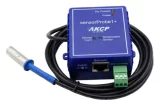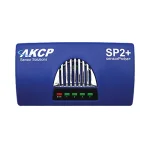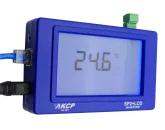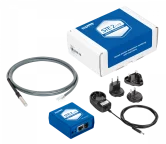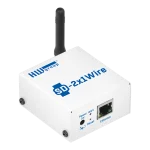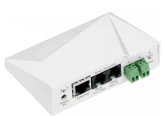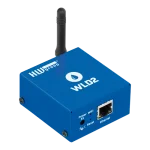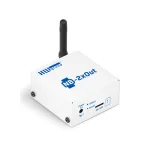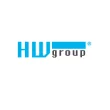Warehouse Environmental Monitoring solutions and sensors for Environment Monitoring in Warehouses
It is relatively easy to install environmental monitoring in a distribution warehouse. A suitable base unit has to be selected to which sensors and detectors can be connected. The environment monitoring base unit and sensors can be hardwired using Ethernet cable or use Wi-Fi and wireless gateway communications. Sensors can monitor temperature, humidity and water leakage with plug-in detectors for smoke, fire, security and even power availability. Alarms and alerts can be sent via email,SMS text messages, phone calls, viewed on on-premises or cloud-based software dashboards.
Monitoring Warehouse Temperature
Bay doors are constantly opening or closing and may even be left open for prolonged periods. This can lead to wide temperature fluctuations and uncontrolled ambient temperatures, cold and hot spots throughout a distribution warehouse. With a widely fluctuating temperature range, HVAC systems have to work harder and this leads to increased energy usage.
Storage and ambient temperature recommendations and guidelines vary depending on what the warehouse is used for. Typical temperature range guidelines vary per country but can include:
- Frozen food: 0°C / 0°F
- Refrigerator chilled food: 1 to 3°C / 34 to 39°F
- Dry food: 10 to 20°C / 50 to 70°F
Temperature sensors, even for low temperature cold chain logistics can be used to monitor and alert when temperatures go outside of pre-set thresholds, anywhere a sensor is installed within the warehouse.
Humidity Monitoring in a Food Storage Warehouse
Maintaining a suitable Relative Humidity (RH) level within a distribution warehouse can be as difficult as it is for temperature. The optimal humidity for a warehouse is 40-50% RH. High humidity can create ideal conditions for mould growth and corrosion or rust on metallic surfaces. High humidity can also lead to electrical short circuits. Low humidity can lead to a build-up of static electricity. Humidity sensors can be installed in a warehouse to monitor levels anywhere they are installede either throug a fixed Ethernet network cable or a Wi-Fi connection to an environmental monitoring base unit.
Flooding and Water Leakage
Flooding and water leakage from air conditioning systems, HVAC system piping or even a nearby river overflow, can destroy the stock held in a distribution warehouse. Installing water leakage spot sensors and sensor ropes can help to provide early detection of water leak event and provide sufficient time for an emergency response.
Security Access Control
Dry contact signals can be used to monitor door opening and closing and alarm when doorway is left open beyond a set time period. This can not only help with access control but also the energy efficiency of the HVAC system installed to provide a temperature and humidity-controlled environment.
Smoke and Fire Monitoring
Dry contacts can also be used to monitor for smoke and fire and integrate with fire control panels and building management systems. Smoke detectors with lights and audible alarms can be installed to monitor zones in a warehouse and provide digital inputs to a base monitoring device.
Environmental Monitoring
Environmental monitoring systems are continuous data loggers for temperature, humidity and for whichever other sensors are connected to an environment monitor. In a warehouse facility, a data logger provides continuous warehouse temperature monitoring; ideal for a food storage warehouse and a distribution warehouse environment that must provide a controlled ambient and humidity controlled environment.
Temperature and humidity stability are vital in distribution warehouses. A continuous monitoring system provides a means for monitoring warehouse temperature and humidity to ensure ambient temperatures and air moisture content. A temperature data logger could be used in isolation, as could a separate humidity monitoring system but for environmental monitoring projects we recommend multi-sensor compatible base units with multiple plug-in sensor ports and digital input (DI) signal contacts for monitoring third-party systems.
Monitoring Base Units Examples
Here is a list of the typical environmental monitoring base units used in warehouse monitoring solutions. The AKCP sensorProbe+ SP1+ has a built-in temperature sensor and an extra sensor port for another plug-in sensor such as an environmental humidity sensor. At the other end of the environmental monitoring range is the AKCP sensorProbe+ SPX8 with 8 ports which can increased to 16 sensors ports and 60 signal dry contacts.
| Model | Built-in Sensor(s) | Plug-in Sensor(s) | Supplied with these Plug-in Sensors | Digital Inputs | Digital Outputs | Ethernet (RJ45) | Protocols | Text Alerts |
|---|---|---|---|---|---|---|---|---|
| sensorProbe SP1+ | Temperature | 1 | – | 1 | 1 | yes, PoE | HTTP, HTTPS, SSL/TLS, SNMP v1, v2, with license v3, Modbus and Radius | email to SMS portal |
| sensorProbe SP2+ | – | 2-4 | – | up to 20 | 1-2 on a sensor port | yes, PoE option | HTTP, HTTPS, SSL/TLS, SNMP v1, v2, with license v3, Modbus and Radius | email to SMS portal or GSM Modem |
| sensorProbeX+ SPX4 | – | 4 | – | up to 10 | 1-4 on a sensor port | yes | HTTP, HTTPS, SSL/TLS, SNMP v1, v2, with license v3, Modbus and Radius | email to SMS portal or GSM Modem |
| sensorProbeX+ SPX8 | – | 8 up to 16 | – | up to 60 | 1-8 on a sensor port | yes | HTTP, HTTPS, SSL/TLS, SNMP v1, v2, with license v3, Modbus and Radius | email to SMS portal or GSM Modem |
Server Room Environments supplies a wide range of environmental monitoring solutions.
Avtech Room Alert and HW Goup Contintuous Monitoring Systems
Avtech Room Alert environnmental monitoring devices are another range to consider for warehouse monitoring. Systems from HW Group are also suitable for monitoring applications in warehouses and include wireless Wi-Fi options.
Please contact our proejcts team to discuss your warehouse environmental monitoring project.

Earn SRE points on all online purchases with double points on selected products



























